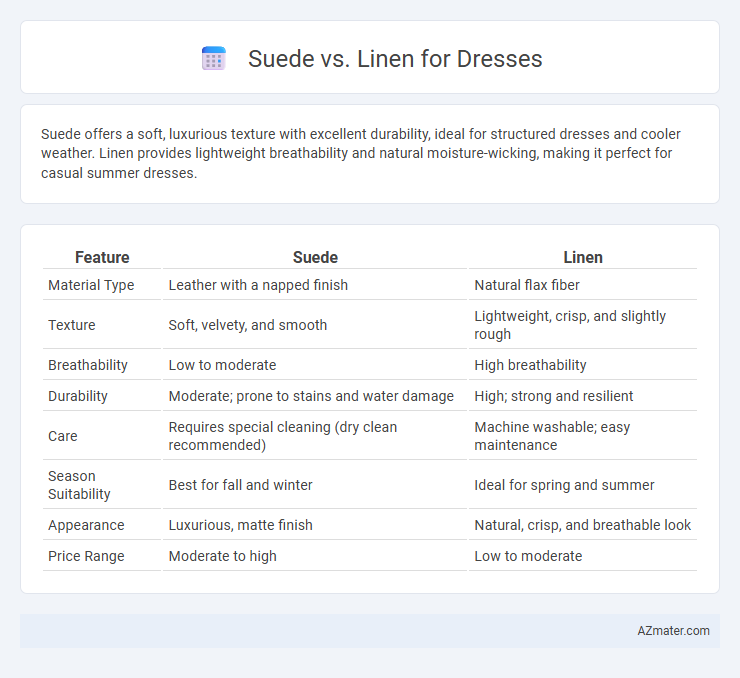Suede offers a soft, luxurious texture with excellent durability, ideal for structured dresses and cooler weather. Linen provides lightweight breathability and natural moisture-wicking, making it perfect for casual summer dresses.
Table of Comparison
| Feature | Suede | Linen |
|---|---|---|
| Material Type | Leather with a napped finish | Natural flax fiber |
| Texture | Soft, velvety, and smooth | Lightweight, crisp, and slightly rough |
| Breathability | Low to moderate | High breathability |
| Durability | Moderate; prone to stains and water damage | High; strong and resilient |
| Care | Requires special cleaning (dry clean recommended) | Machine washable; easy maintenance |
| Season Suitability | Best for fall and winter | Ideal for spring and summer |
| Appearance | Luxurious, matte finish | Natural, crisp, and breathable look |
| Price Range | Moderate to high | Low to moderate |
Introduction to Suede and Linen Fabrics
Suede, a type of leather with a napped finish, offers a soft texture and luxurious appearance ideal for elegant dresses. Linen, derived from flax fibers, provides breathability and a naturally crisp feel suitable for warm-weather attire. Both fabrics bring unique qualities to dressmaking, balancing style, comfort, and durability.
Origins and History of Suede and Linen
Suede, derived from the French term "gants de Suede," originated in the 19th century as a softened leather made from the inner surface of animal hides, primarily lamb, goat, or calfskin, prized for its velvety texture and durability in fashion. Linen, traced back over 4,000 years to ancient Egypt and Mesopotamia, is made from the flax plant fibers and is renowned for its breathability, strength, and natural luster, historically favored for warm climates and fine garments. Both materials have evolved through centuries, with suede gaining popularity in Western luxury apparel and linen maintaining its status as a sustainable, lightweight fabric ideal for summer dresses.
Texture and Appearance: Suede vs Linen
Suede offers a soft, velvety texture with a matte finish that exudes luxury and warmth, making it ideal for elegant, structured dresses. Linen, by contrast, features a crisp, slightly rough texture with a natural sheen and visible weave, lending a breathable, casual, and lightweight appearance perfect for summer attire. The tactile difference between suede's smooth nap and linen's airy, textured surface significantly affects the dress's overall aesthetic and suitability for different occasions.
Breathability and Comfort Comparison
Linen offers superior breathability compared to suede, making it ideal for warm weather dresses due to its lightweight and moisture-wicking properties. Suede, made from the underside of animal hides, is heavier and less breathable, which can trap heat and reduce comfort in hot climates. For optimal comfort in dress fabrics, linen is preferred for its natural airflow and softness, while suede suits cooler conditions thanks to its plush texture.
Durability and Longevity Factors
Suede, made from the underside of animal hide, offers a soft texture but tends to be less durable and more prone to water damage compared to linen, which is a natural fiber known for its strength and breathability. Linen dresses excel in longevity due to their resistance to wear and tear, maintaining structural integrity through multiple washes without significant degradation. For long-lasting dress options, linen provides superior durability, especially in warm climates, while suede requires careful maintenance to preserve its appearance over time.
Suitability for Different Climates
Suede dress materials offer excellent warmth and breathability, making them ideal for cooler climates and fall or winter wear, while linen is highly breathable and moisture-wicking, perfect for hot and humid environments. Linen suits provide superior airflow and comfort during summer months, preventing overheating and promoting ease of movement. Choosing between suede and linen depends on climate-specific needs, with suede excelling in insulation and linen in cooling properties.
Maintenance and Care Requirements
Suede dresses require delicate care, including avoiding water exposure and using specialized suede brushes and cleaners to maintain their soft texture and prevent staining. Linen dresses are easier to care for, as they can often be machine-washed or hand-washed, though they may wrinkle easily and benefit from ironing or steaming to maintain a crisp appearance. Both fabrics demand specific maintenance to preserve their look, but suede generally necessitates more cautious handling to avoid damage.
Style Versatility: Formal vs Casual Options
Suede dresses offer a rich, textured appearance ideal for sophisticated, formal events, evoking luxury and warmth with their soft, matte finish. Linen dresses present exceptional style versatility, lending a crisp, breathable fabric perfect for casual, daytime wear yet easily elevated with accessories for semi-formal occasions. Choosing between suede and linen depends on the desired balance between polished elegance and laid-back comfort in dress styling options.
Environmental Impact and Sustainability
Suede and linen differ significantly in environmental impact and sustainability, with linen being a more eco-friendly choice due to its natural origin from flax plants that require minimal water and pesticides during cultivation. Suede, typically derived from animal hides, involves resource-intensive processes including livestock raising, which contributes to higher greenhouse gas emissions and water usage. Choosing linen for dresses supports sustainable fashion by reducing carbon footprint and promoting renewable agricultural practices.
Choosing the Right Fabric for Your Dress
Suede offers a luxurious, soft texture ideal for structured dresses and cooler weather, while linen provides breathability and a lightweight feel perfect for warm climates and casual styles. Consider the dress's purpose and season: suede lends durability and elegance for formal occasions, whereas linen ensures comfort and moisture-wicking properties for everyday wear. Evaluating fabric maintenance is crucial, as suede requires careful cleaning, whereas linen is more forgiving and easy to care for.

Infographic: Suede vs Linen for Dress
 azmater.com
azmater.com